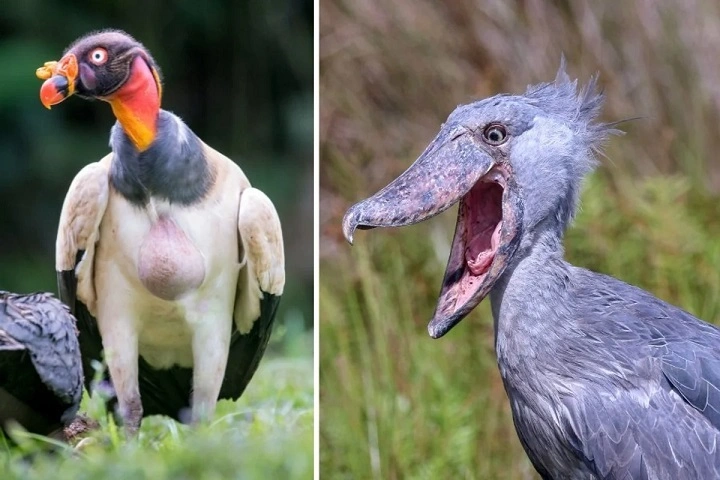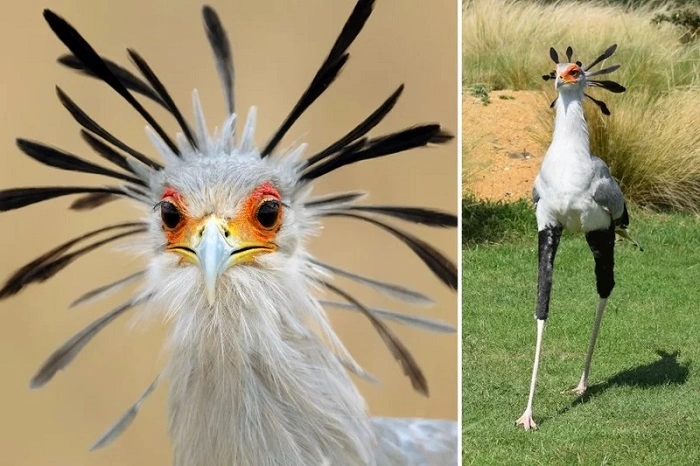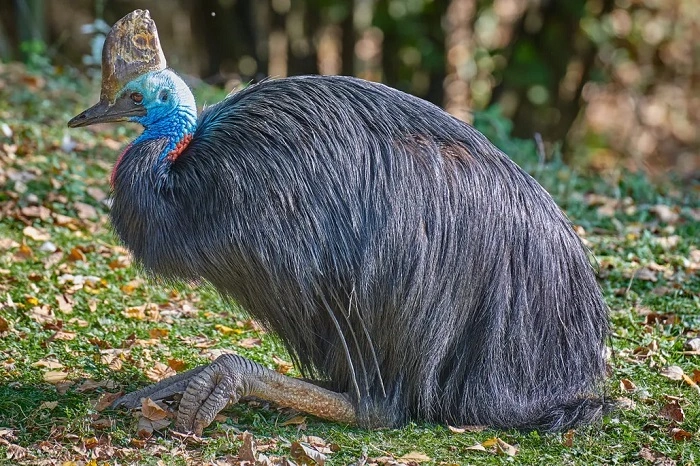Birds are everywhere. There are some of them that are beautifully colored, others that are beauties to inspire awe, and others that simply leave us in hobbles of amazement. They number in thousands, with only meager dozens of those odd shaped ones. They are the odd shaped birds—creatures that bewilder our brains on what is normal, challenge our imagination, and show us that nature is endlessly creative.
The first time you see them, you ask yourself: “How is this possible?” But each strange beak, each strange feather, each strange eye is there for a reason. They’re not accidents. They’re design. And every single one of them has something to tell us about surviving, about adapting, about coming back.
Why Do Some Birds Look So Strange?
What is strange to us is likely perfect evolution.
- Amazing beaks are refrigerators, digging tools, or crackers for their meals.
- Bald heads turn scavengers into sanitary eaters when they consume carrion.
- Strange feathers and wattles do the job to attract mates or push away competitors.
- Stiff body placements assist with camouflage or equilibrium.
And so, although people call them strange, nature calls them a success. These birds are living life as they were designed.
The Shoebill: A Silent Giant
Leaning over in the East African marshes like a statue is the shoebill. It measures around four feet nine inches high and creeps tiny, its eyes poking out with an expression that appears prehistoric. Its beak resembles a wooden shoe—wide, blunt, and strange-looking. It is usually called prehistoric.
But in that peculiar face lies genius. The beak is the sole strong point of the shoebill when it comes to fighting lungfish, catfish, and even young crocodiles. The shoebill waits patiently, and then strikes at once ferociously. Its peculiarity lies in its power.
And that gaze? It is not wicked. It is concentration. The shoebill stands motionless, quiet, and powerful.
The Hoatzin: A Living Relic
Deep in the rainforests of the Amazon lives the hoatzin, perhaps the most strange-looking living bird. Its spiky crest, red-rimmed eyes, and jerky flight make it resemble something from another time. And in many ways, it is.
Hoatzins were born from eggs with clawed wings. They leave shells in water in emergencies, swim back onto land, and crawl back onto trees on their claws. Adults first ferment leaves in the stomach before eating them, which are pungent manure-scented. The locals refer to them as “stinkbirds.”
Weird? Yes. But the hoatzin belongs to a family that dates back millions of years. It’s proof that life exists, even in the weirdness.
The Kakapo: New Zealand’s Gentle Giant
Imagine a parrot that cannot fly. A parrot that ambles across mossy forests like a woolly owl. That’s the kakapo.
Gangly, nocturnal, large, the kakapo had thrived in New Zealand’s early predator-free world. But with man came cats, dogs, and stoats, and the kakapo was appalling close to extinction. Its own defense system of remaining immobile where it was effective against native predators but not against introduced predators.
And so, through collective conservation, the kakapo flourishes once more. Each and every one is monitored, named, and nurtured. It’s odd, maybe, but it’s precious. Odd has become a sign of hope.
The Marabou Stork: Africa’s Undertaker
Swayed and curved, bald rosy head and prodigious throat pouch, no handsome man is the marabou stork. It frequents around garbage dumps and dead bodies and looks macabre. “Undertaker bird” is what it’s also nicknamed because of its black wings and shambling, stumbling walk.
But marabou storks are required. Foraging for carrion and garbage, disease-resistant, they clean ecosystems of filth. Exposed heads prevent them from becoming infected while scrounging for food. What we find offensive is in fact a necessity. They remind us that everything beautiful isn’t basking in sunlight—there are some which work behind the scenes for service.
The Potoo: Ghost of the Night
To the unaided eye, upon first glance, the potoo is little more than a sliver of snapped twig. Standing on its legs in the daylight, as stiff as a board, eyes closed tight, it is bark-like. But after dark, it is a very different bird.
It possesses colossal yellow eyes that expand into gigantic pupils, and a crunching bill with which it snaps up insects. Its look is strange—flat face, wide beak, sleepily eyed face—but it’s an expert at camouflage. When it lets out its ghostly call, the otherworldly sound travels miles at night. The potoo teaches us that mystery must be permitted in nature.
The Long-Wattled Umbrellabird
Black-feathered, crested, and with feathers falling in a cascade like an umbrella, this South American bird has a fairly bizarre look already. And to complete the picture: its most bizarre feature, its fanned feathered wattle, hanging down from the center of its chest.
Blow-up males puff out this wattle while they sing, making deep booming calls that carry miles. Its looks might be goofy to us, but in the jungle, that booming call is a message. Weirder here is beauty.
The Guianan Cock-of-the-Rock
In South America’s rainforests, fleeting glimpses of orangeakers flash between the branches. They are male cock-of-the-rocks, the strangest bird dancers. They sport fan-crested heads that cover nearly all their heads, so that they are round and fruit-shaped.
On display, ten or twelve will assemble and flaunt, bounding, calling, and displaying its beauty. It is noisy, untidy, and captivating. The bird is clumsy as a solitary bird, but on display it’s lovely.
The Secretary Bird: Thane on Stilts
Half eagle, half crane, the bird is long and lean with feathers like quills on the rear of its head and long legs. It’s an office dress code type of bird, therefore it’s been dubbed the “secretary bird.”
But its appearance misleads its potency by far. With perhaps the deadliest snake-killing abilities in Africa, with the potential to kill poisonous snakes by poisonous kicks in seconds. Unusual appearance? Yes. But swaggering about with confidence, warrior in disguise.
The Frogmouth: Wide-Mouthed Oddity
A cousin of the potoo, frogmouth boasts a flat, wide beak that is cartoon-like. Dopey-eyed and short-legged, they look like clowns perched on branches. But they are so well camouflaged on tree trunks, they become nonexistent.
Their strange mouths are useful when they are night-flying predators, catching insects by snapping their jaws shut. Their strangeness covers their power.
Other Unusual Birds That Deserve Attention
- California Condor – Wrinkled, bald-headed nine-foot-plus wingspan vulture-sized scavenger. Old in appearance, but important in function.
- Helmeted Hornbill – Its large casque atop the bill makes it an odd-appearing bird. Sadly, hunted for its casque, it is now critically endangered.
- King Vulture – Painted-colored with its multi-colored bald head, it’s a showy appearance. Its purpose is to scavenge dead animals.
- Great Curassow – With curved feathers that look like a crown of springs, it almost looks mythical.
Each of these birds is magical in some way.
Why We Call Them Weird Looking
We have learned to love symmetry, sleek feathers, and smooth flight. Anything else looks unnatural. But these birds thrive just because they are unnatural.
- The shoebill beak allows it to catch food other birds can’t.
- The bare marabou head maintains it in good condition.
- Mossy kakapo feathers allow it to camouflage perfectly.
- Hoatzin claws save chicks from death.
Odd features are all survival done in feathers written.
The Symbolism of Oddness
In fables and societies, strange birds symbolize cleverness, mystery, or change. An odd appearing bird is like a warning sign: don’t judge too soon. What seems ridiculous can be powerful. What seems ugly might have beauty that you have not yet learned to see.
Aren’t we the same? Everyone has their imperfections. Everyone looks strange in someone else’s perspective. Birds remind us: difference is power.
Encounters That Last
Go ask travelers who have laid eyes on the shoebill. They never forget that unblinking stare. Go ask ecologists who approach the kakapo. They murmur about its hapless charm between the tears they have wept.
Encounters with outlandish birds make an impression because they break assumptions. They remind us the world is not only beautiful and graceful—it is also perilous, alien, and unpredictable.
Weird Looking Birds FAQs
Which bird is the weirdest?
The hoatzin usually gets the award because of its claws, diet, and odor.
Do birds struggle to survive due to appearance?
Not so much. Its features are survival adaptations, but humans have pushed some of them to extinction.
Why are weird birds usually described as prehistoric?
Because their appearance is like old fossils or early features in previous avian evolution.
What is the weirdest looking weird looking bird?
The kakapo, reduced to below 100, now slowly recovers with conservation.
Why are some birds so unsettling?
Unusual eyes, out-of-proportion features, or baldness unsettle us because they break habitual patterns of beauty.
Ugly looking birds are more than a novelty. They are living animals lessons in survival, purpose, and imagination. They shatter our restricted definition of beauty and compel us to look closer. Each weird beak or bald head speaks of survival. Each gangly posture has an adaptation ideally suited to its environment.
And the other is foreign. The potoo and the shoebill are foreign. If you glance at a picture of them, don’t just laugh. Stop. Marvel. Ask yourself what story those birds would tell in their feathers. In strangeness, there is understanding. In oddness, there is consideration. Because strange does not mean evil—strange means wonder.




